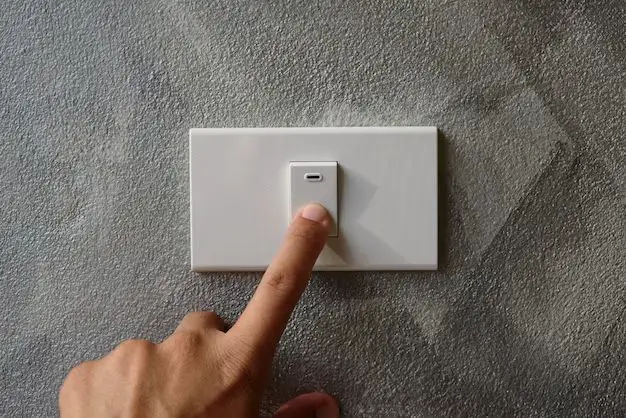It can be frustrating when a light switch starts flickering on and off. A flickering light switch is usually a sign of a larger electrical issue that needs to be addressed. In this article, we’ll go over the most common causes of a flickering light switch and steps you can take to troubleshoot the issue.
Page Contents
Quick Diagnosis
Here are some of the most common reasons a light switch may flicker on and off:
- Loose light switch connections
- Faulty light switch
- Overloaded circuit
- Faulty light fixture
- Faulty bulb
- Damaged or worn out wires
Flickering that only happens when a light is turned on likely indicates an issue with the light switch itself, like a bad connection. Flickering that persists even after the switch is turned off points to a wiring problem elsewhere in the circuit.
How to Troubleshoot a Flickering Light Switch
Here are some steps to take to get to the bottom of a flickering light switch:
- Check light bulbs – Screw bulbs in tightly, replace old bulbs
- Test with a different light fixture – Plug in a lamp to outlet to isolate issue
- Check connections – Turn off power, remove switch plate, check wires are tight
- Replace light switch – Bad switches are a common cause of flickering
- Check for backstabbed wires – These can come loose and cause flickering
- Check circuit breaker – Reset breaker or replace if faulty
- Inspect all wiring – Check for damaged wires that need to be replaced
- Update home electrical system – Have an electrician inspect system and make repairs
Carefully going through these troubleshooting steps can help zero in on the source of the problem. Safety should always come first when dealing with electrical issues.
Common Causes of a Flickering Light Switch
Let’s take a more in-depth look at some of the most common culprits behind a flickering light switch:
Loose Wire Connections
Loose wire connections or wires that have pulled out of their terminals can interrup power intermittently and cause flickering. This could occur at the light switch itself, in the light fixture, or elsewhere in the circuit. Tightening up loose wire connections is typically an easy fix.
Old/Faulty Light Switch
If a light switch is old and worn out, the internal contacts can become pitted or burned and may no longer connect properly. A faulty switch that doesn’t make solid contact will cause flickering whenever you try to turn on the light. Replacing the switch will solve the issue.
Overloaded Circuit
Having too many devices, lights, or appliances on the same circuit can overload it and cause voltage drops that lead to flickering. Check to make sure you don’t exceed the
| Circuit Type | Maximum Capacity |
|---|---|
| 15 amp circuit | 1800 watts |
| 20 amp circuit | 2400 watts |
Spread out devices over more circuits to alleviate an overload.
Faulty Light Fixture
Flickering can be the result of a failing light fixture with a bad ballast or internal wiring issues. Bypass the fixture and test the switch by plugging a lamp directly into the outlet. If the switch works properly, it’s an issue with the light fixture.
Deteriorating Wires
Outdated wiring that’s in poor condition can have worn or cracked insulation that exposes bare wires. This can lead to intermittent contact and voltage drops that cause flickering. Have an electrician inspect and update old wiring as needed.
When to Call an Electrician
Take caution when dealing with flickering lights and know when to call a professional electrician. Seek professional help if:
- Flickering persists after replacing light switch
- Circuit breaker frequently trips
- You see scorch marks/melting around switches
- Wiring looks damaged/frayed
- You lack experience working with electrical
A licensed electrician can use a multimeter to test voltage and current flow to pinpoint the exact cause of flickering. They can safely make necessary wiring repairs and upgrades.
Home Electrical Safety Tips
Here are some general tips to keep your home’s electrical system in good working order:
- Use surge protectors for electronics
- Avoid overloading circuits
- Label all circuit breakers
- Use light bulbs with correct wattage
- Replace old outlets and wiring
- Have a licensed electrician for major repairs
- Check for hot plugs/switches
- Keep flammables away from electrical
Preventative Maintenance
Regularly checking your home’s electrical system can help prevent flickering switches and other issues. Add these tasks to your maintenance schedule:
- Check condition of light switches, replace loose/worn ones
- Check wiring connections are tight
- Clean dirt/dust buildup on switches and fixtures
- Check circuit loads and redistribute if overloaded
- Look for signs of electrical arcing/overheating
- Check ground fault and arc fault interrupters
- Listen for buzzing/crackling from switches or outlets
Conclusion
Flickering light switches are an annoyance and potentially hazardous. With some diligent troubleshooting and electrical maintenance, you can likely solve the issue on your own. If the problem persists or you discover wiring damage, call a professional. Keep safety the top priority when dealing with flickering lights.
